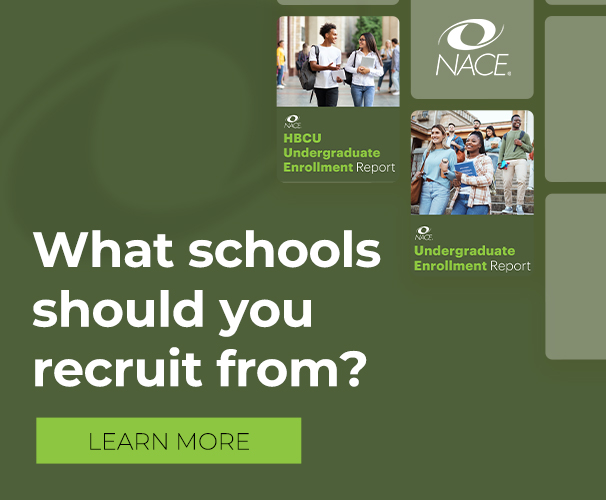Spotlight for Recruiting Professionals
Before last summer, Dell Technologies had a traditional perspective on new graduate talent, with its college graduate hiring efforts focused on recruiting those with bachelor’s degrees for entry-level positions.
However, as part of the commitments Dell made to address racial injustice, the company launched an initiative to expand its talent pipeline overall, but, in particular, to attract underrepresented minorities.
“When I think about where we were prior,” says Robert Simmons, Dell Technologies’ talent acquisitions senior manager, “while we hired people with associate degrees for certain job roles, we were really only focused on recruiting university graduates matriculating with a bachelor’s degree. That limited our talent pool, and we knew there was so much more talent out there.
“We reevaluated our structure on the heels of George Floyd to determine what we were doing and what our answer was going to be. The solution was to expand our definition of what we consider to be recent graduate talent to include associate degrees, apprenticeships, and certificate programs. We want to look much broader than the norm.”
Conversations began in March 2020 and continued into the summer as the Dell team started laying the program’s foundation and building its infrastructure. Dell’s community college initiative officially launched in February 2021.
“The launch included headcounts, looking at where our partnerships would be, and expanding into education opportunities with Dell, for example, helping schools develop STEM curriculum to prepare students for roles in technology,” Simmons explains.
Although the community college initiative is a key catalyst, Dell’s work around diversity and inclusion ramped up nearly two years prior to its launch, with the announcement of the company’s Progress Made Real 2030 goals. Simmons says that in 2019, Dell launched a robust outline of where Dell was going in terms of diversity and inclusion, sustainability, ethics, and privacy, and what the company is doing to transform lives with technology
“This included our moonshot goals, which were very definitive and very direct about what Dell needed to do to close the gap in many parts of our organization,” he notes.
“The career part was that we had a big gap in underrepresented minorities, particularly Black/African-Americans and Latino/Hispanics. Knowing this, we put together what’s called a ‘cultivating inclusion’ goal, where, by 2030, 25% of our team members in the United States will be those who identify as Black/African-American or Hispanic/Latino, and 15% of our leadership will be those who identify as Black/African-American or Hispanic/Latino.”
Altering its definition of recent graduate talent and broadening its talent pool gives Dell access to much more talent, specifically to tech talent from diverse populations.
“We can set up our own boot camps and apprentice-style scenarios and we can partner with community colleges, which oftentimes are very local entities with local diversity and inclusion workforce development initiatives, to help enable their strategies,” Simmons points out.
“Employees don’t need an advanced degree or a business background for every job in tech. Coding or working on hardware doesn’t always require a four-year degree. Are there some skills that employees may need that are very specific, like a certain language to code in? Yes, but you can teach those within boot camps or apprenticeship-style programs. A bachelor’s degree may be something that employees go on to get later on, but it’s not necessary in order to gain access to the role itself.”
In its work with community colleges, Dell lends its industry knowledge and expertise to the partnerships.
“When you think about the curriculum and about the industry standards for our needs and what it takes to come in and work at the likes of a Dell or other tech company, we provide knowledge about and support for the critical skills students need,” Simmons says.
“The work that we’ve done thus far with the schools is mostly on the consulting edge. There’s an expanded part of our team that helps us with curriculum development. My team will help bring community colleges to the table to have conversations with our instructional designers to do curriculum review. They will compare the school’s current curriculum with our offering and take opportunities to marry them.”
These partnerships also include Dell serving on advisory boards and talking about emerging trends, flexible work, and new types of skills that are entering into the workforce. Dell makes its campus connections in three areas.
“The key to entry,” Simmons says, “is career services. We develop strong partnerships with career services at each of our schools.
“The next level is getting ingrained with the faculty and staff. This is where a lot of the advisory board conversations come in. The third level, but certainly not the least important, is the students. We partner with students, which may include individual students or the leadership of student organizations. We are at all of these levels, but we bring them together to recruit talent to bring into Dell.”
Currently, Dell is working with approximately 12 community colleges—all located on the East Coast and in the Midwest—and has begun the process at another 12.
“When I think about what each side brings to the table, it’s a lot of conversation around enabling students to transition into the workforce and be successful when doing so,” Simmons says.
“We have three distinct goals for the program: extending digital access to help close the digital divide, building a workforce that is more representative of society, and opening pathways to careers in tech for those early in their career. While we’re still early in this initiative, we are seeing the benefits of this work.”
Simmons and Megan Evangelista, diversity team lead in university relations, offer recommendations for other employers looking to bolster their diversity and inclusion efforts.
“To address problems, you have to think about things from a different perspective,” Simmons says.
“We know that authenticity and building trust are key components of strengthening diversity and inclusion efforts, so open up the playbook and try different things, maybe some that you would never try in your traditional recruiting efforts.”
For example, he says, Dell is developing an externship program in its work with community colleges.
“The reason we are doing this is, oftentimes, a traditional community college student may not have the means or ability to stop whatever they are doing midlife and intern at a company for 90 days, then go back to that life,” Simmons says.
“We are creating an externship that provides on-the-job training in a much shorter time period to acclimate students to Dell’s culture. It will provide skill-building, career readiness, and networking, and bridge the gap between our internal team and the students.”
Adds Evangelista: “The other piece that we talk a lot about on our team and that links to this population is to meet students where they are. Our team has regular discussions, check-ins, and brainstorming sessions about how we can meet students in the classroom, in their clubs and activities, and more.
“We are looking at serving this population with a fresh set of eyes and not taking anything for granted or assuming that they are available for an extended period of time to intern with us, or that they have resumes prepared, or that they can meet with us during normal business hours. This has challenged us in a good way to rethink how we support students. It has also brought out some really creative solutions.”






